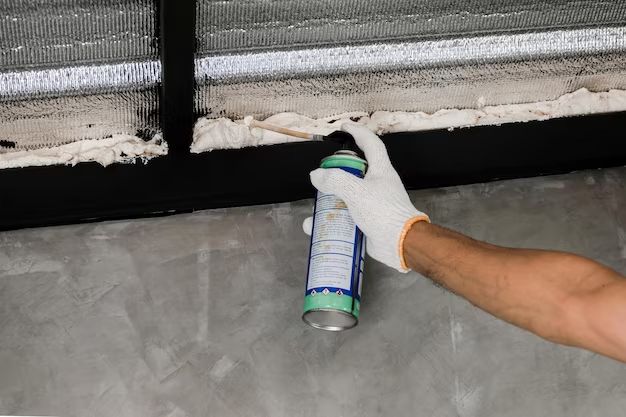Spray foam that hardens is a type of insulation that is applied as a liquid and then expands and solidifies to fill cracks and spaces. The two main types of spray foam that harden are closed-cell spray foam and open-cell spray foam. When properly installed, this spray foam insulation creates a seamless barrier to air infiltration and provides excellent thermal performance.
Page Contents
What are the main types of spray foam insulation?
There are two main types of spray foam insulation that harden after application:
Closed-cell spray foam
Closed-cell spray foam is made up of tiny closed foam cells that are filled with a gas. The gas gives the foam its R-value, or resistance to conductive heat flow. Closed-cell foam has an R-value of around R-6 to R-7 per inch.
The closed-cell structure of this foam also makes it impervious to moisture, which helps prevent mold growth. Closed-cell foam provides a high-density barrier to air infiltration and is the most rigid foam insulation available, able to help support framing members.
The closed-cell nature and density also allow it to provide excellent sound transmission reduction properties, blocking exterior noise from entering the building.
Open-cell spray foam
Open-cell spray foam consists of tiny foam bubbles that are not completely closed off from each other. The open-cell structure allows the foam to expand more than closed-cell when applied.
Open-cell foam has an R-value of R-3 to R-4 per inch. The open-cell structure allows for water vapor transmission through the foam so it is more permeable to moisture.
While it does not provide as high of a vapor barrier as closed-cell foam, open-cell foam is still an effective air barrier sealant. The open-cell structure cannot support framing members, however.
What are the key differences?
Here is a comparison of some key differences between closed-cell and open-cell spray foam:
| Characteristic | Closed-Cell Foam | Open-Cell Foam |
|---|---|---|
| R-value per inch | R-6 to R-7 | R-3 to R-4 |
| Density | Higher density | Lower density |
| Air infiltration barrier | Excellent | Good |
| Moisture permeability | Low | Higher |
| Rigidity | Very rigid | Less rigid |
| Sound blocking | Excellent | Good |
As you can see, the main differences come down to closed-cell foam having a higher R-value, density, rigidity, air infiltration barrier, and sound blocking compared to open-cell foam. However, open-cell foam is more moisture permeable.
What ingredients are in spray foam insulation?
The main ingredients in both open-cell and closed-cell spray foam typically include:
– Polyurethane resin – This helps provide structure and foam characteristics.
– Catalysts – Catalysts help initiate the foaming reaction.
– Blowing agents – Blowing agents, like hydrofluoroolefins, help the foam expand and fill spaces.
– Surfactants – Surfactants regulate cell formation and stabilization.
Closed-cell foam also includes polymeric isocyanate compounds to help seal foam cells. The specific ingredients and ratios will vary between different spray foam manufacturers.
How does spray foam insulation work?
Spray foam insulation works through a chemical reaction and expansion process:
1. The isocyanate and resin are mixed together in the spray foam machine. Catalysts and blowing agents are added as well.
2. As the mixture is sprayed from the nozzle, the catalyst causes the isocyanate and resin to rapidly react with each other.
3. The blowing agent causes the reactants to expand up to 30-60 times their liquid volume.
4. Within minutes, the foam solidifies into insulation with millions of tiny cells filled with the gaseous blowing agent for insulation performance.
5. The foam adheres and molds to the shape of the surfaces it is sprayed onto, forming a complete seal.
What are the benefits of spray foam insulation?
There are several key benefits that make spray foam insulation a top choice:
– High insulation value – Spray foam can insulate 2-3 times better than other insulation materials of the same thickness.
– Air sealing – Foam completely fills gaps and spaces, eliminating spots for air leaks. This can reduce energy costs.
– Moisture resistance – Closed-cell spray foam forms a vapor barrier to prevent moisture issues.
– Noise reduction – The dense foam dampens noise and exterior sounds.
– Durability – Spray foam holds up well over time and resists settling and compression.
– Applicability – Foam easily adheres to any shape or substrate.
– Reduced airborne pests – The sealed foam keeps out unwanted pests.
What are the downsides to spray foam?
Some potential downsides to consider include:
– Higher cost – The material cost per square foot is higher than fiberglass or cellulose.
– Installer expertise – Improper installation can lead to poor insulation performance.
– Chemical concerns – Some people may prefer more natural insulation materials.
– Surface prep needed – Surfaces must be clean and dry for spray foam application.
– Odor – Some odor may linger during and after installation.
Conclusion
In summary, spray foam that hardens provides insulation through an expanded cellular structure that adheres and forms a barrier wherever it is sprayed. The closed-cell or open-cell nature of the foam impacts its R-value, rigidity, and permeability. Spray foam insulation offers benefits like air sealing, noise reduction, and moisture control. While spray foam is more expensive upfront than other insulations, it makes up for this in energy savings over time. With proper installation, spray foam can be an excellent insulating solution.
